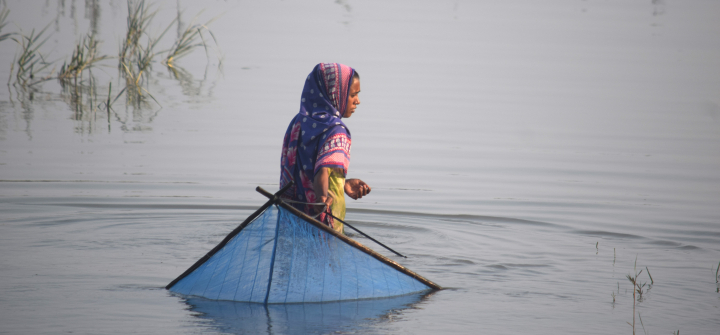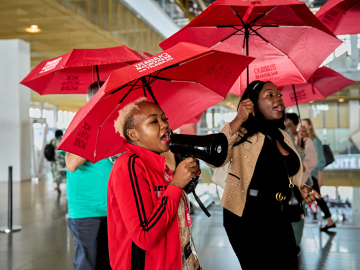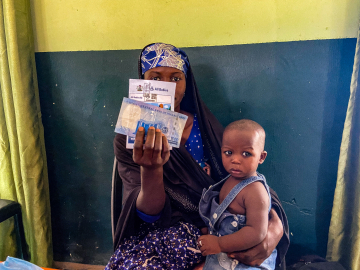Silent Killer: Saltwater Threatens Women’s Health in Coastal Bangladesh
SHYAMNAGAR, Bangladesh—On a Sunday afternoon last September, hundreds of women and children throng the banks of the Kholpetua River near Burigoalini village. Everyone wields a blue net and tries to catch baby shrimp, called fry.
Most stand in the salty water for nine to 10 hours per day. The same scene is repeated across coastal Bangladesh.
Jamena Begum and thousands of other women (and some men) in coastal Bangladesh survive by catching shrimp. They can earn about 250 taka (US$2) by selling 400–500 fry to shrimp farmers. After raising the shrimp for several months, shrimp farmers can eventually earn 5,000 taka (US$45) by selling them to restaurants in major cities in Bangladesh and abroad.
Begum fishes with her 10-year-old daughter until a storm begins to roll in. As the tide rises and the river swells, they give up fishing and leave for home.
Their health, however, isn’t just threatened from the storms that frequent southwestern Bangladesh, but by the salt water that’s intruding into the Kholpetua—and their lives.
An estimated 20 million people in coastal Bangladesh are affected by increased salinity in drinking water, per a 2018 article in the Journal of Agricultural Economics. The pond water many use for drinking is often saline—and in the dry season, undrinkable. During monsoon season, the salinity of pond and river water is reduced, and it can be used for cooking and bathing. For much of the year, households along the coast buy 20-liter drums of water for 30 taka (US$0.27)—though even water brought in by truck or boat can have a high salt content.
Women in the region are at special risk of skin infections and reproductive disorders because they stand for long days in saline water (water with significant concentrations of dissolved salts). In southwestern Bangladesh, more than half of women in two subdistricts reported infection or inflammation of the vagina, uterus, fallopian tubes, or ovaries, according to a 2024 Journal of Migration and Health study. More than one in three respondents said they had menstrual hygiene management problems, and one in five reported hypertension during pregnancy. More than 1 in 100 had their uterus surgically removed due to chronic bleeding, infection, or tumors.
“Alternative livelihoods for women and equitable social safety net programs should be ensured to overcome the crisis,” says Md Shamsuddoha, the study’s lead author and executive director of the Center for Participatory Research and Development in Bangladesh.
Firoza Begum (no relation to Jamena Begum) lives in Burigoalini village and also fishes on the Kholpetua River. She is focused on survival and sees limited options for her family. “What will I eat if I don’t catch shrimp fry?” she says. “It is very difficult to run a family. I can earn something by catching shrimp fry. But I have suffered from bone pain, urinary tract infections, and skin diseases due to working in salt water for a long time.”
Jamena Begum is blunter as she assesses the water’s impact on her life: “That water destroys us. That water is our salvation.”

Jamena Begum, from Burigoalini village in coastal Bangladesh has been living with salt water for most of her life. Rafiqul Islam Montu
Rising Risks
Increased water salinity will hit coastal Bangladesh hard, according to a 2014 World Bank report, putting people in the 19 coastal districts at greater risk.
“It is no longer a secret that global warming and climate change are causing oceans to warm and sea levels to rise,” says Atiq Rahman, executive director of the Bangladesh Center for Advanced Studies. “As a direct consequence of rising sea levels and inundation of coastal villages, water sources and soil salinity in Bangladesh’s coastal areas have increased alarmingly.”
Water sources for low-lying coastal villages on the country’s west coast are often flooded by seawater, increasing salinity in the groundwater, Rahman notes. Frequent cyclones, such as Cyclone Aila in 2009, have caused saltwater intrusion into freshwater aquifers; and shrimp farming has further increased salinity in the region’s water. Because farmers have found shrimp to be more profitable than rice, they create large-scale ponds on agricultural land and inject salt water in them to raise the crustaceans.
During the dry season, water flow in the rivers on the coast is sharply reduced, allowing tidal water from the sea to enter the rivers. Salinity has increased, for example, in the Kirtkhola River in Barisal and the Madhumati River in Gopalganj, 150 and 200 kilometers (93 and 124 miles) inland, respectively.
Studies, such as a 2022 Spanish Journal of Soil Science report indicate that the salinity crisis will increase in the future, further endangering the health of thousands of coastal women.
High Costs of a Life Tied to Salt Water
As soon as the doors of Gabura Union Health Center open at 8:30 a.m., the waiting room quickly fills up. A woman comes in with pain in her hip joint. Another woman has urinary problems. Yet another tells the doctor that she has been suffering from fever for a long time.
Dozens of women seek care at the health center in Gabura Union, a river island the government considers a climate-vulnerable area about 40 kilometers (25 miles) from the Bay of Bengal. The women have various health problems, but a significant number of cases relate to saltwater.
“We cannot avoid salinity. Salinity is our silent killer,” says Kakali Begum, of Gabura village. “Most of the women in this area are suffering from urinary tract diseases. Many women are having sores, skin diseases. Excessive use of salt water is causing miscarriages in women. Due to uterine problems, many people are voluntarily having abortions.”
Santosh Kumar Majumder, a gynecology consultant in the Dakop Upazila (sub-district) Health Complex, estimates that 60% of the people in the region drink salt water, which can be especially harmful to pregnant mothers. “It causes high blood pressure which in turn may cause eclampsia or seizures during pregnancy. These may lead to miscarriages or an underweight and malnourished baby,” Majumder says, echoing a 2016 Medical Hypotheses article.
In fact, the prevalence of gestational seizures and high blood pressure is much higher among people living in coastal areas than in other parts of the country, according to a 2011 Environmental Health Perspectives study by Imperial College of London and BCAS researchers who blame the trend on the use of saline water.
Md Shaheen, a health officer in the Mongla Upazila Hospital believes saline water is causing other reproductive problems for women in the region. Data from the hospital suggests that saltwater disrupts the menstrual cycle. Stories of girls' early menstruation are common along the coast.
“Many girls in this region start their period at 8–9 years,” long before the typical menarche age of 11–12, Shaheen says. “Hormonal changes in girls occur quickly as a result of excess salt intake.”

Households in southwestern Bangladesh use salt water for daily needs, despite the risks. Rafiqul Islam Montu
The Search for Solutions
Public and private initiatives offer at least some hope for reducing the impact of climate change-driven saltwater intrusion into ground and surface waters. These efforts include rainwater harvesting, pond sand filters, and making saltwater potable through desalination. Some projects provide free drinking water, while others sell water at reduced rates. Many residents collect rainwater on their own, aided by organizations that are distributing free rainwater tanks to poor families.
One of the notable initiatives to address the water crisis is the government’s Gender-Responsive Coastal Adaptation (GCA) project. With UNDP support, the GCA helps 140,000 people harvest rainwater.
The efforts offer little protection, however, for women who have long been exposed to the dangers posed by saline water.
“I ended my own life while fighting for life and livelihood,” says Gabura Island resident Sarbanu Begum. “The doctor said a hysterectomy would cost 55,000 taka (US$500). But where do I get the money? I don't want to suffer more in the future.”
After another day catching shrimp in the Kholpetua River, Jamena Begum returns to her village with her daughter. She eyes the storm as it closes in and reflects on her work.
“From birth to death we live with salt,” she says. “We survive for ages fighting salt water. This fight is getting tougher as time passes. Salt water gives us the opportunity to earn [money], but this salt water makes us sick. We are stuck in a cycle of saltiness. In case of illness, we do not have the opportunity to receive proper treatment. We have no choice but to accept fate. This is our life.”
Rafiqul Islam Montu is a Dhaka-based award-winning investigative journalist in Bangladesh. He covers climate, environment, science, coastal communities, public health, disasters, humanitarian, and Indigenous issues.
Ed. Note: This article is part of Global Health NOW’s Local Reporting Initiative, made possible through the generous support of loyal GHN readers.
Join the 50,000+ subscribers in over 170 countries who rely on Global Health NOW summaries and exclusive articles for the latest public health news. Sign up for our free weekday newsletter, and please share the link with friends and colleagues.
Teenager Hasina Begum and her neighbors risk skin infections by fishing for hours every day in the salty Kholpetua River in southwestern Bangladesh. Rafiqul Islam Montu





